pipe FIAT MAREA 2001 1.G Workshop Manual
[x] Cancel search | Manufacturer: FIAT, Model Year: 2001, Model line: MAREA, Model: FIAT MAREA 2001 1.GPages: 330
Page 42 of 330
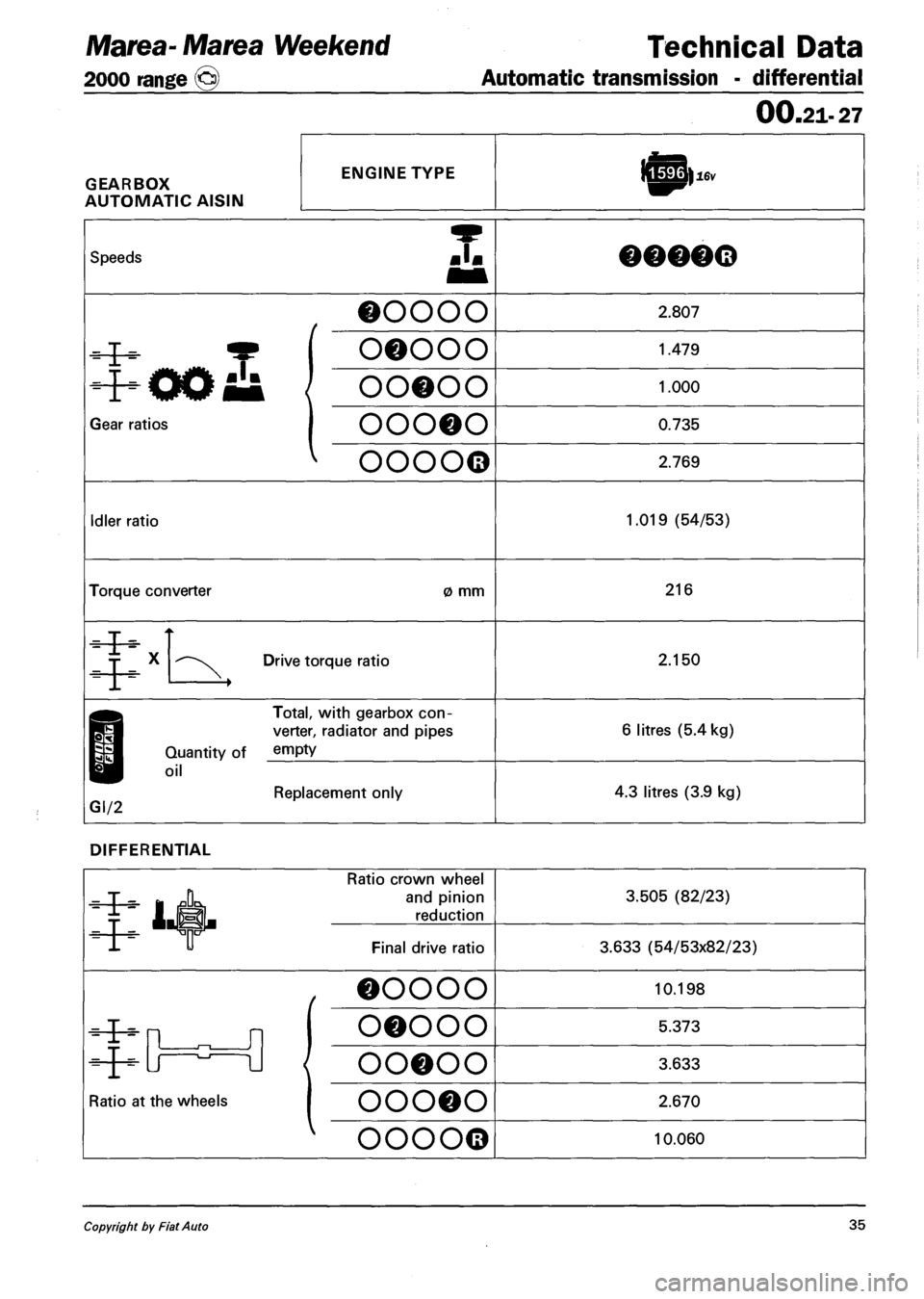
Marea- Marea Weekend
2000 range (§)
Technical Data
Automatic transmission - differential
GEARBOX
AUTOMATIC AISIIM
ENGINE TYPE
00.21-27
Speeds .1. ooooq
ooooo
.1,
OOOOO
ooooo
Gear ratios OOOOO
oooo©
2.807
1.479
1.000
0.735
2.769
Idler ratio 1.019 (54/53)
Torque converter 0 mm 216
T X Drive torque ratio 2.150
Quantity of
oil
Total, with gearbox con
verter, radiator and pipes
empty
GI/2 Replacement only
6 litres (5.4 kg)
4.3 litres (3.9 kg)
DIFFERENTIAL
Ratio crown wheel
and pinion
reduction
Final drive ratio
3.505 (82/23)
3.633 (54/53x82/23)
OOOOO
OOOOO
OOOOO
Ratio at the wheels OOOOO
OOOO©
10.198
5.373
3.633
2.670
10.060
Copyright by Fiat Auto 35
Page 70 of 330
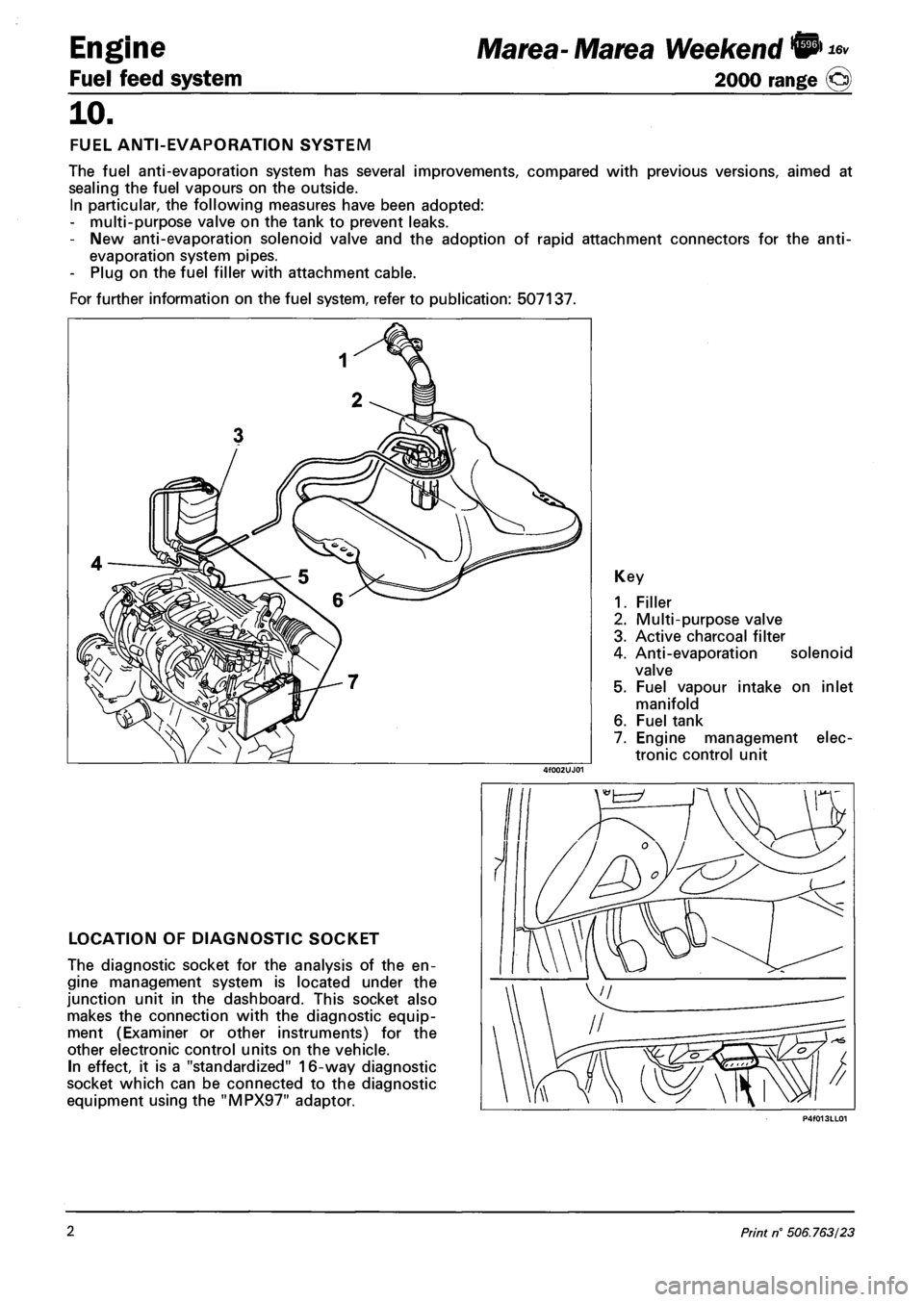
Engine
Fuel feed system
Marea- Marea Weekend
2000 range @
10.
FUEL ANTI-EVAPORATION SYSTEM
The fuel anti-evaporation system has several improvements, compared with previous versions, aimed at
sealing the fuel vapours on the outside.
In particular, the following measures have been adopted:
- multi-purpose valve on the tank to prevent leaks.
- New anti-evaporation solenoid valve and the adoption of rapid attachment connectors for the anti-
evaporation system pipes.
- Plug on the fuel filler with attachment cable.
For further information on the fuel system, refer to publication: 507137.
Key
1. Filler
2. Multi-purpose valve
3. Active charcoal filter
4. Anti-evaporation solenoid
valve
5. Fuel vapour intake on inlet
manifold
6. Fuel tank
7. Engine management elec
tronic control unit
LOCATION OF DIAGNOSTIC SOCKET
The diagnostic socket for the analysis of the en
gine management system is located under the
junction unit in the dashboard. This socket also
makes the connection with the diagnostic equip
ment (Examiner or other instruments) for the
other electronic control units on the vehicle.
In effect, it is a "standardized" 16-way diagnostic
socket which can be connected to the diagnostic
equipment using the "MPX97" adaptor.
2 Print n° 506.763/23
Page 74 of 330
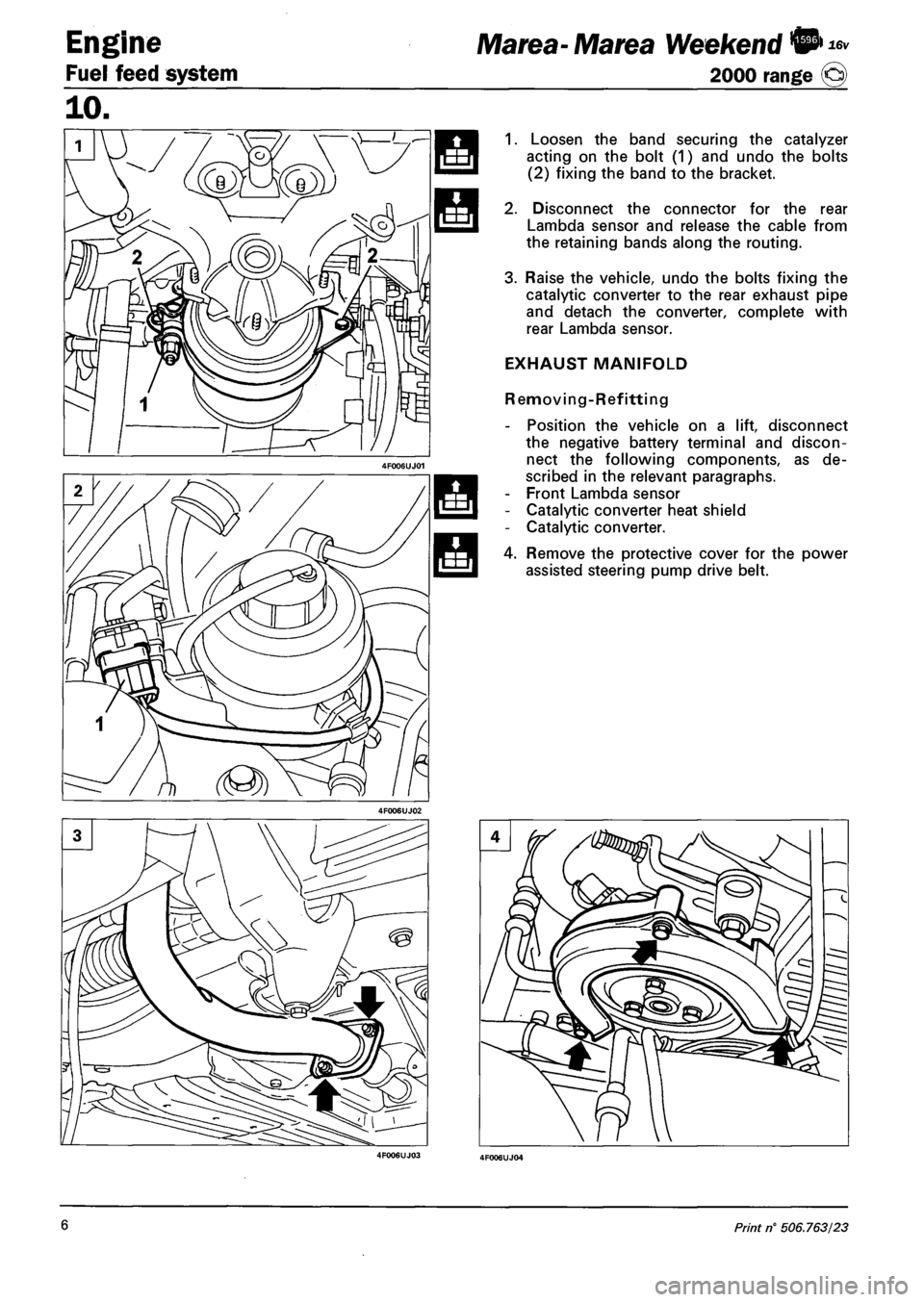
Engine
Fuel feed system
16v Marea- Marea Weekend ©
2000 range @
1. Loosen the band securing the catalyzer
acting on the bolt (1) and undo the bolts
(2) fixing the band to the bracket.
2. Disconnect the connector for the rear
Lambda sensor and release the cable from
the retaining bands along the routing.
3. Raise the vehicle, undo the bolts fixing the
catalytic converter to the rear exhaust pipe
and detach the converter, complete with
rear Lambda sensor.
EXHAUST MANIFOLD
Removing-Refitting
- Position the vehicle on a lift, disconnect
the negative battery terminal and discon
nect the following components, as de
scribed in the relevant paragraphs.
- Front Lambda sensor
- Catalytic converter heat shield
- Catalytic converter.
4. Remove the protective cover for the power
assisted steering pump drive belt.
6 Print n° 506.763/23
Page 75 of 330
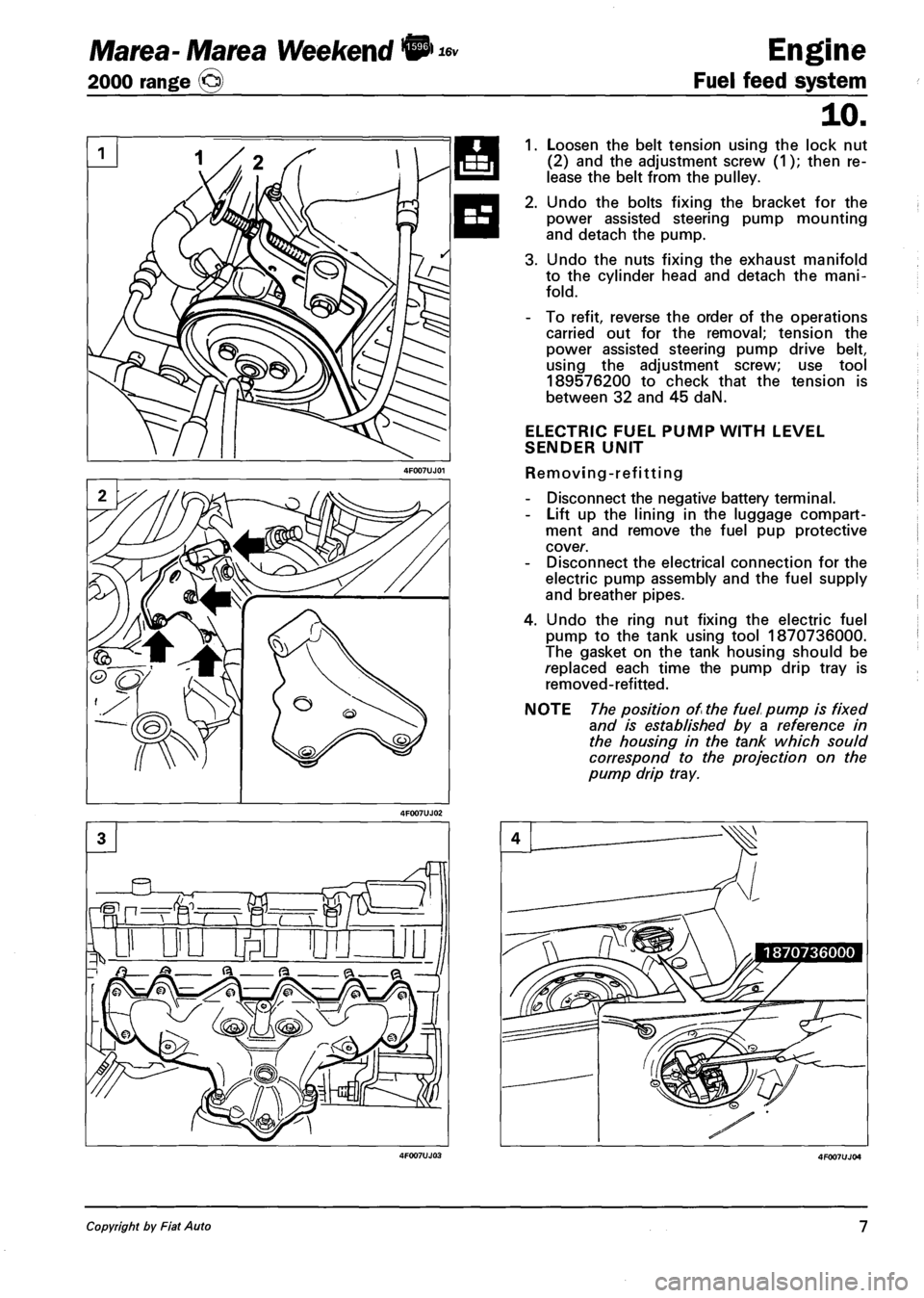
Marea- Marea Weekend •
2000 range ©
16v Engine
Fuel feed system
10.
1. Loosen the belt tension using the lock nut
(2) and the adjustment screw (1); then re
lease the belt from the pulley.
2. Undo the bolts fixing the bracket for the
power assisted steering pump mounting
and detach the pump.
3. Undo the nuts fixing the exhaust manifold
to the cylinder head and detach the mani
fold.
- To refit, reverse the order of the operations
carried out for the removal; tension the
power assisted steering pump drive belt,
using the adjustment screw; use tool
189576200 to check that the tension is
between 32 and 45 daN.
ELECTRIC FUEL PUMP WITH LEVEL
SENDER UNIT
Removing-refitting
- Disconnect the negative battery terminal.
- Lift up the lining in the luggage compart
ment and remove the fuel pup protective
cover.
- Disconnect the electrical connection for the
electric pump assembly and the fuel supply
and breather pipes.
4. Undo the ring nut fixing the electric fuel
pump to the tank using tool 1870736000.
The gasket on the tank housing should be
replaced each time the pump drip tray is
removed-refitted.
NOTE The position of the fuel pump is fixed
and is established by a reference in
the housing in the tank which sou Id
correspond to the projection on the
pump drip tray.
Copyright by Fiat Auto 7
Page 78 of 330
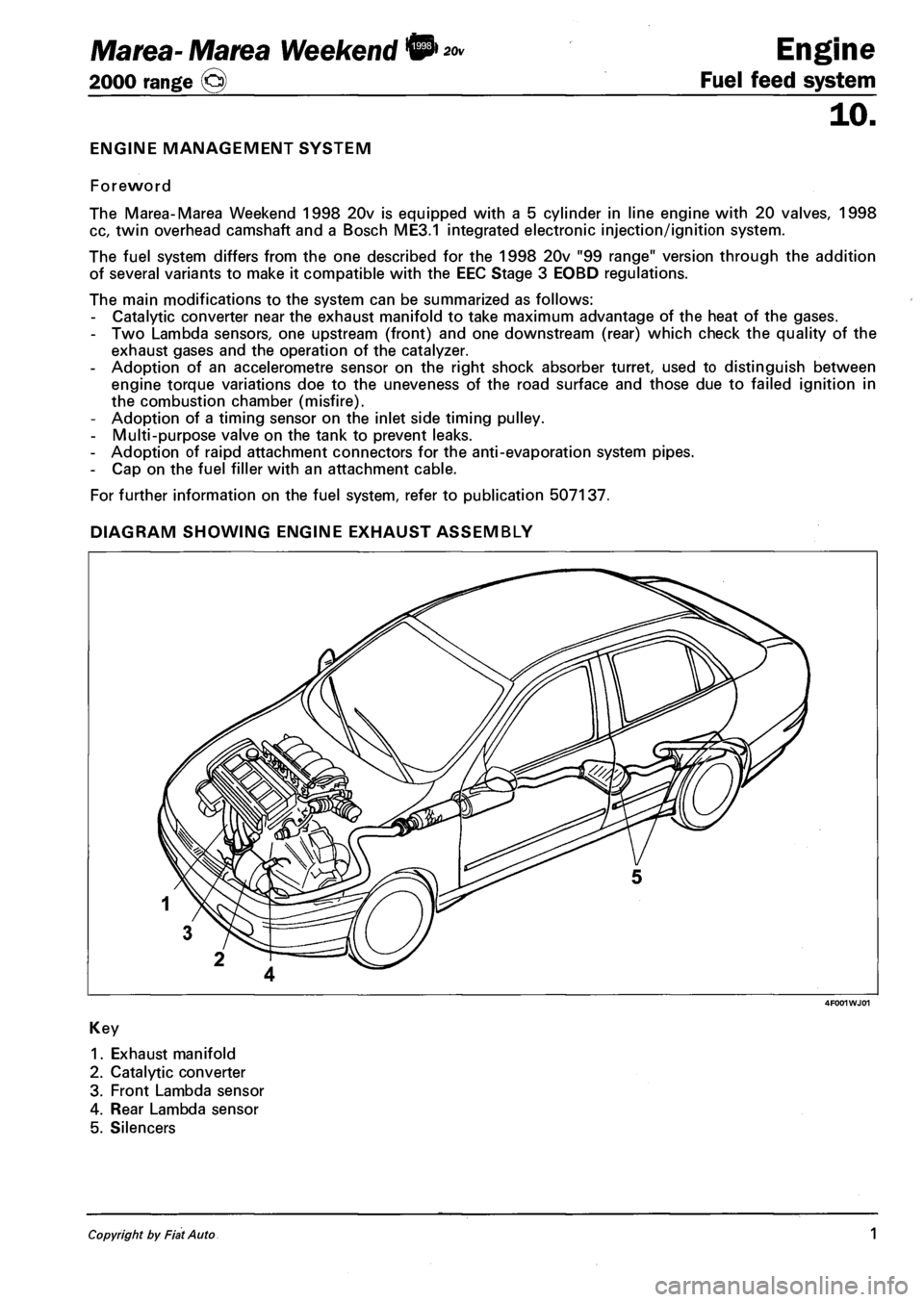
Marea- Marea Weekend & Engine
2000 range (§) Fuel feed system
ENGINE MANAGEMENT SYSTEM
Foreword
The Marea-Marea Weekend 1998 20v is equipped with a 5 cylinder in line engine with 20 valves, 1998
cc, twin overhead camshaft and a Bosch ME3.1 integrated electronic injection/ignition system.
The fuel system differs from the one described for the 1998 20v "99 range" version through the addition
of several variants to make it compatible with the EEC Stage 3 EOBD regulations.
The main modifications to the system can be summarized as follows:
- Catalytic converter near the exhaust manifold to take maximum advantage of the heat of the gases.
- Two Lambda sensors, one upstream (front) and one downstream (rear) which check the quality of the
exhaust gases and the operation of the catalyzer.
- Adoption of an accelerometre sensor on the right shock absorber turret, used to distinguish between
engine torque variations doe to the uneveness of the road surface and those due to failed ignition in
the combustion chamber (misfire).
- Adoption of a timing sensor on the inlet side timing pulley.
- Multi-purpose valve on the tank to prevent leaks.
- Adoption of raipd attachment connectors for the anti-evaporation system pipes.
- Cap on the fuel filler with an attachment cable.
For further information on the fuel system, refer to publication 507137.
DIAGRAM SHOWING ENGINE EXHAUST ASSEMBLY
4F001WJ01
Key
1. Exhaust manifold
2. Catalytic converter
3. Front Lambda sensor
4. Rear Lambda sensor
5. Silencers
Copyright by Fiat Auto 1
Page 82 of 330
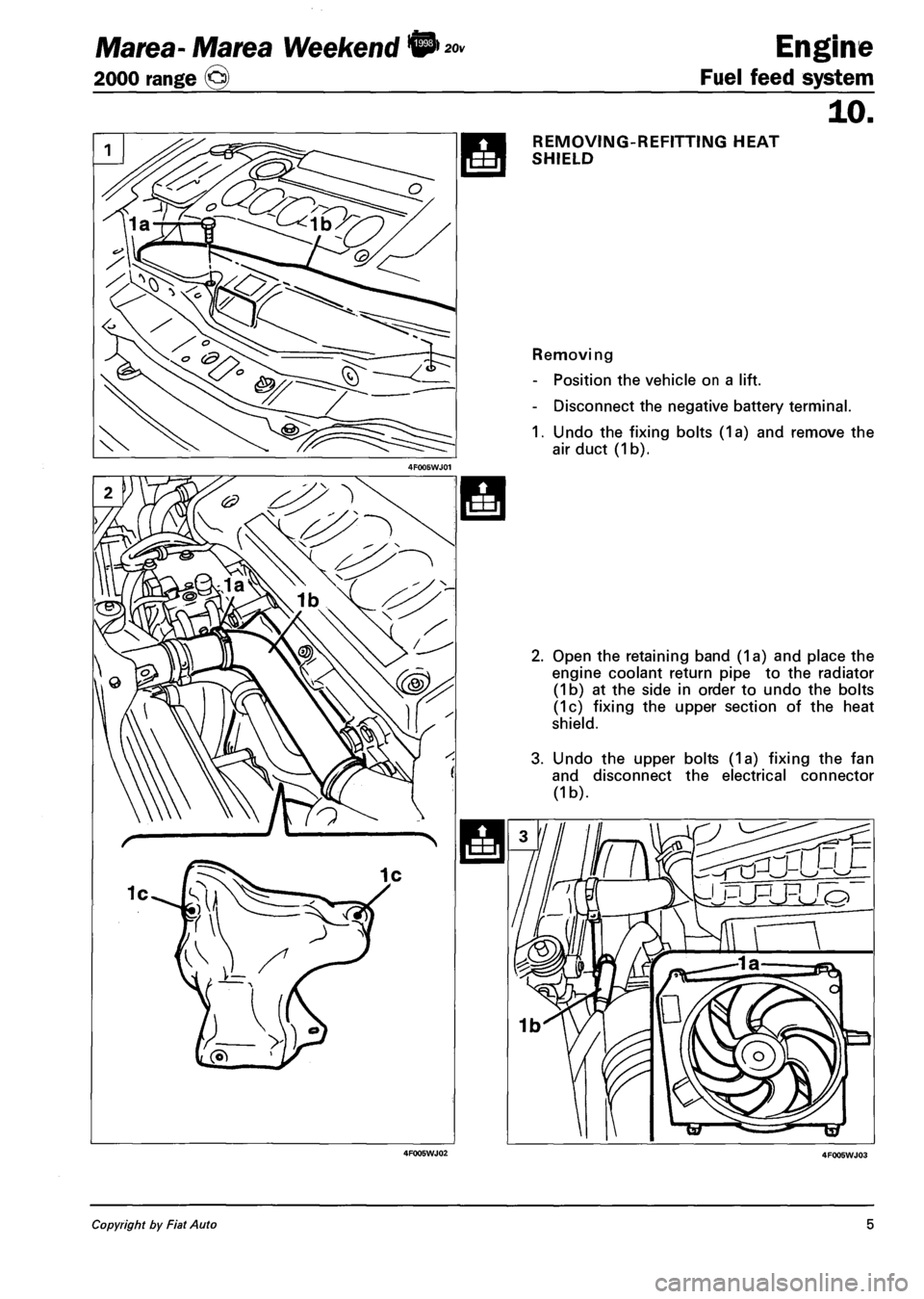
Marea-Marea Weekend •
2000 range (§)
4F005WJ02
Engine
Fuel feed system
10.
REMOVING-REFITTING HEAT
SHIELD
Removing
- Position the vehicle on a lift.
- Disconnect the negative battery terminal.
1. Undo the fixing bolts (1a) and remove the
air duct (1b).
2. Open the retaining band (1a) and place the
engine coolant return pipe to the radiator
(1b) at the side in order to undo the bolts
(1c) fixing the upper section of the heat
shield.
3. Undo the upper bolts (1a) fixing the fan
and disconnect the electrical connector
(1b).
4F005WJ03
Copyright by Fiat Auto 5
Page 84 of 330
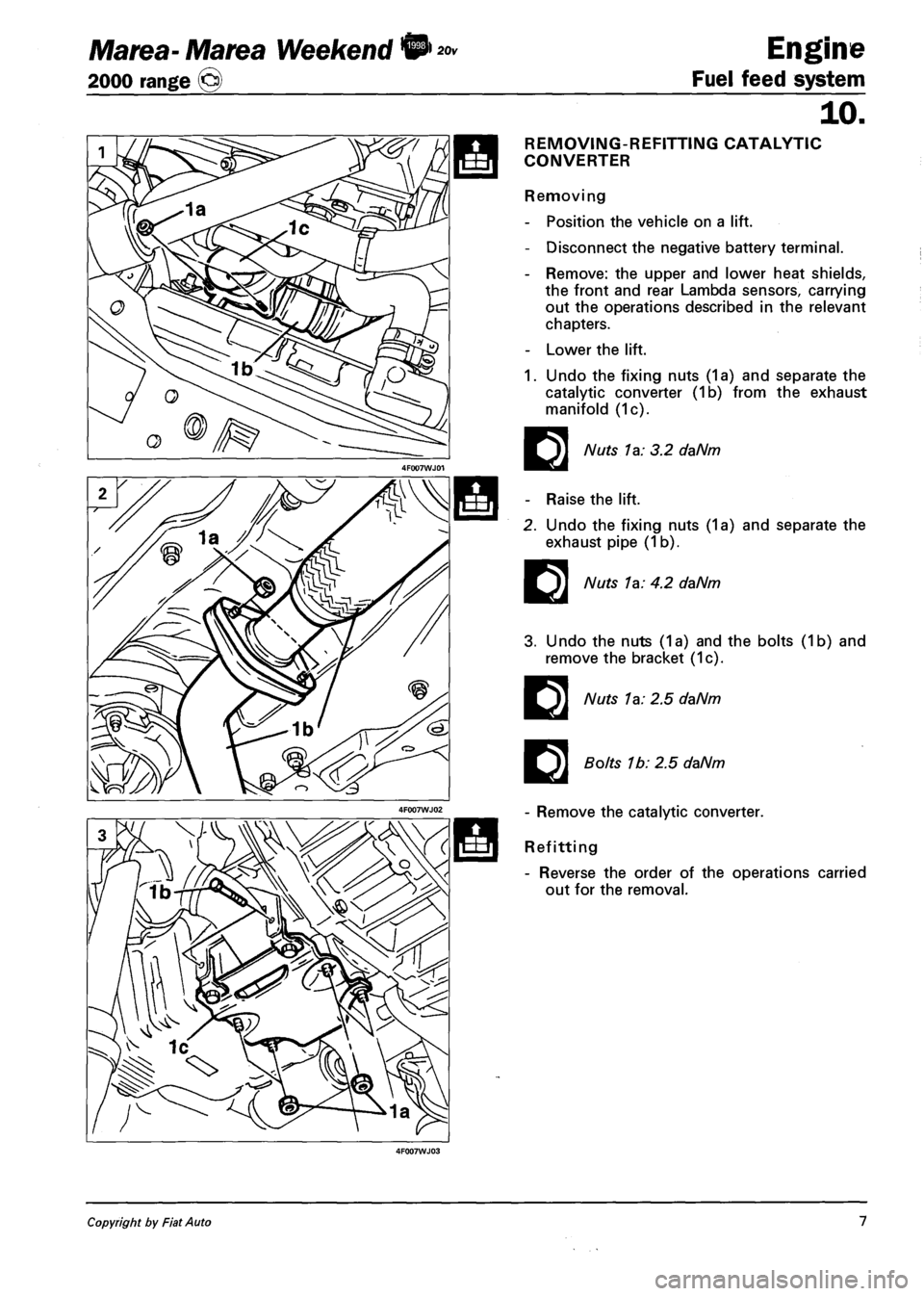
Marea- Marea Weekend 9
2000 range ©
Engine
Fuel feed system
10.
REMOVING-REFITTING CATALYTIC
CONVERTER
Removing
- Position the vehicle on a lift.
- Disconnect the negative battery terminal.
- Remove: the upper and lower heat shields,
the front and rear Lambda sensors, carrying
out the operations described in the relevant
chapters.
- Lower the lift.
1. Undo the fixing nuts (1a) and separate the
catalytic converter (1b) from the exhaust
manifold (1c).
E
Nuts la: 3.2 daNm
- Raise the lift.
2. Undo the fixing nuts (1a) and separate the
exhaust pipe (1 b).
EI
Nuts 1a: 4.2 daNm
3. Undo the nuts (1a) and the bolts (1b) and
remove the bracket (1c).
E
E
Nuts 1a: 2.5 daNm
Bolts 1b: 2.5 daNm
- Remove the catalytic converter.
Refitting
- Reverse the order of the operations carried
out for the removal.
Copyright by Fiat Auto 7
Page 100 of 330
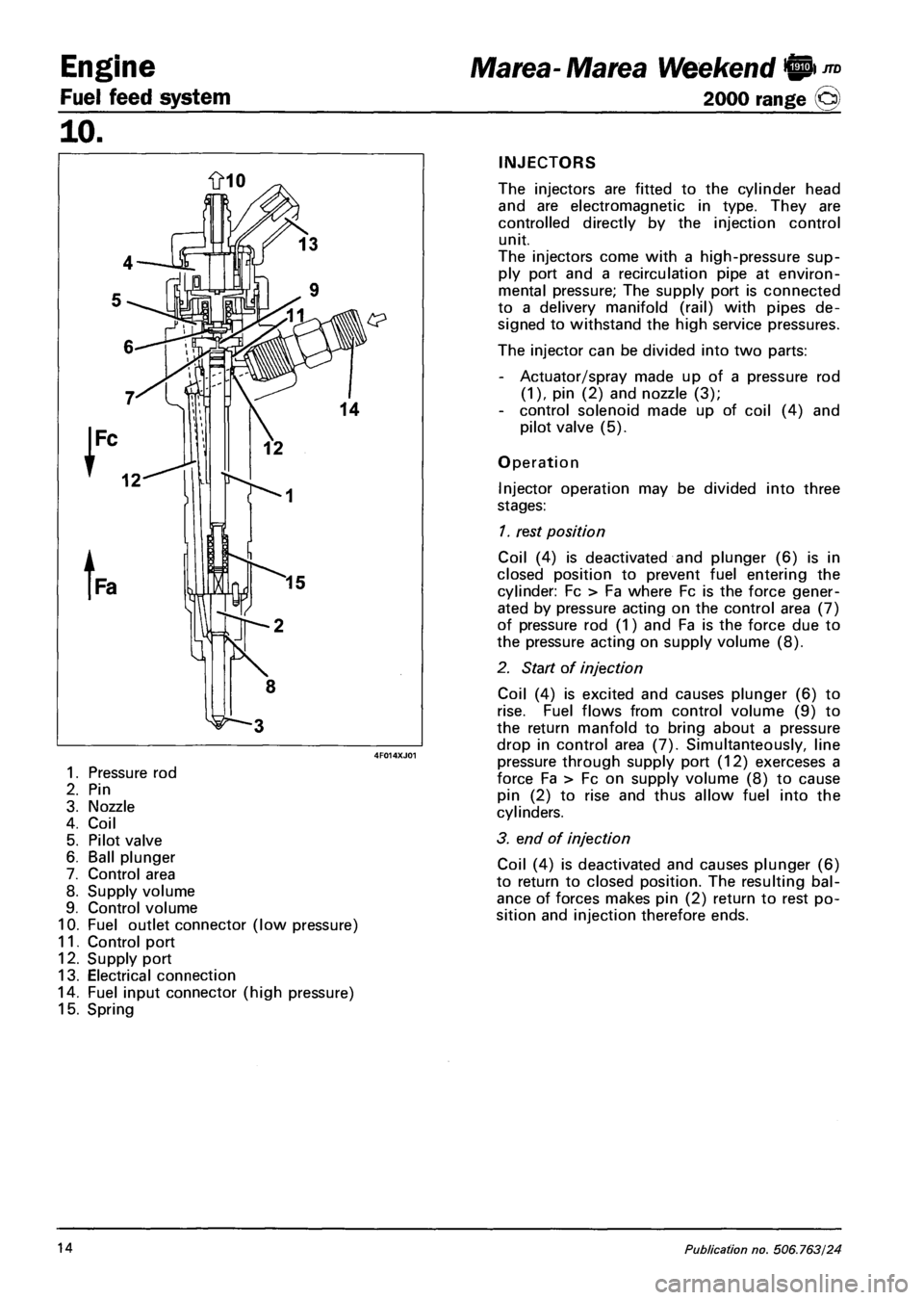
Engine
Fuel feed system
10.
1. Pressure rod
2. Pin
3. Nozzle
4. Coil
5. Pilot valve
6. Ball plunger
7. Control area
8. Supply volume
9. Control volume
10. Fuel outlet connector (low pressure)
11. Control port
12. Supply port
13. Electrical connection
14. Fuel input connector (high pressure)
15. Spring
Marea- Marea Weekend 9 ™
2000 range (Q)
INJECTORS
The injectors are fitted to the cylinder head
and are electromagnetic in type. They are
controlled directly by the injection control
unit.
The injectors come with a high-pressure sup
ply port and a recirculation pipe at environ
mental pressure; The supply port is connected
to a delivery manifold (rail) with pipes de
signed to withstand the high service pressures.
The injector can be divided into two parts:
- Actuator/spray made up of a pressure rod
(1), pin (2) and nozzle (3);
- control solenoid made up of coil (4) and
pilot valve (5).
Operation
Injector operation may be divided into three
stages:
1. rest position
Coil (4) is deactivated and plunger (6) is in
closed position to prevent fuel entering the
cylinder: Fc > Fa where Fc is the force gener
ated by pressure acting on the control area (7)
of pressure rod (1) and Fa is the force due to
the pressure acting on supply volume (8).
2. Start of injection
Coil (4) is excited and causes plunger (6) to
rise. Fuel flows from control volume (9) to
the return manfold to bring about a pressure
drop in control area (7). Simultanteously, line
pressure through supply port (12) exerceses a
force Fa > Fc on supply volume (8) to cause
pin (2) to rise and thus allow fuel into the
cylinders.
3. end of injection
Coil (4) is deactivated and causes plunger (6)
to return to closed position. The resulting bal
ance of forces makes pin (2) return to rest po
sition and injection therefore ends.
14 Publication no. 506.763/24
Page 104 of 330
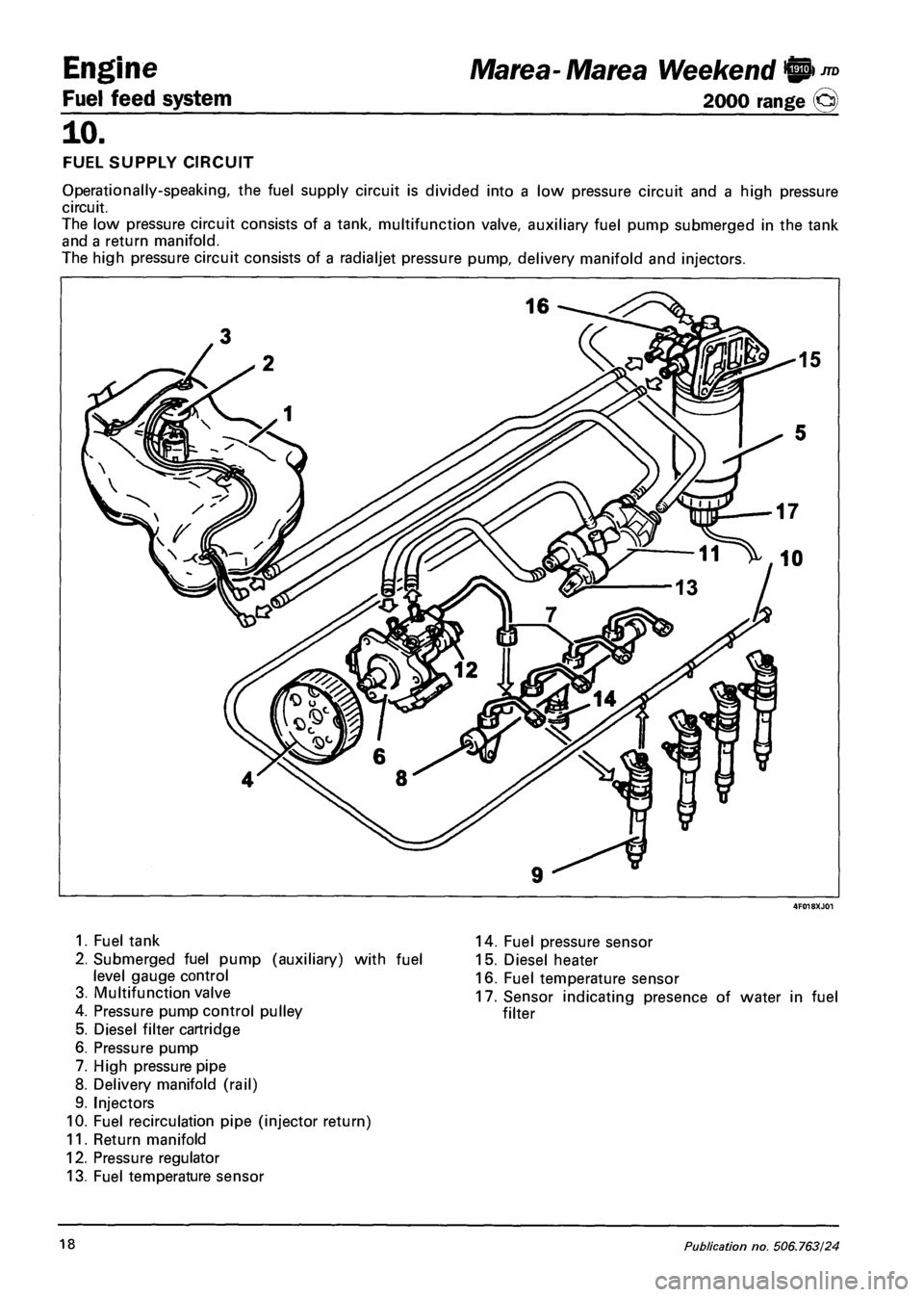
Engine
Fuel feed system
JTD Marea- Marea Weekend 0
2000 range ©
10.
FUEL SUPPLY CIRCUIT
Operationally-speaking, the fuel supply circuit is divided into a low pressure circuit and a high pressure
circuit.
The low pressure circuit consists of a tank, multifunction valve, auxiliary fuel pump submerged in the tank
and a return manifold.
The high pressure circuit consists of a radialjet pressure pump, delivery manifold and injectors.
1. Fuel tank
2. Submerged fuel pump (auxiliary) with fuel
level gauge control
3. Multifunction valve
4. Pressure pump control pulley
5. Diesel filter cartridge
6. Pressure pump
7. High pressure pipe
8. Delivery manifold (rail)
9. Injectors
10. Fuel recirculation pipe (injector return)
11. Return manifold
12. Pressure regulator
13. Fuel temperature sensor
14. Fuel pressure sensor
15. Diesel heater
16. Fuel temperature sensor
17. Sensor indicating presence of water in fuel
filter
18 Publication no. 506.763/24
Page 107 of 330
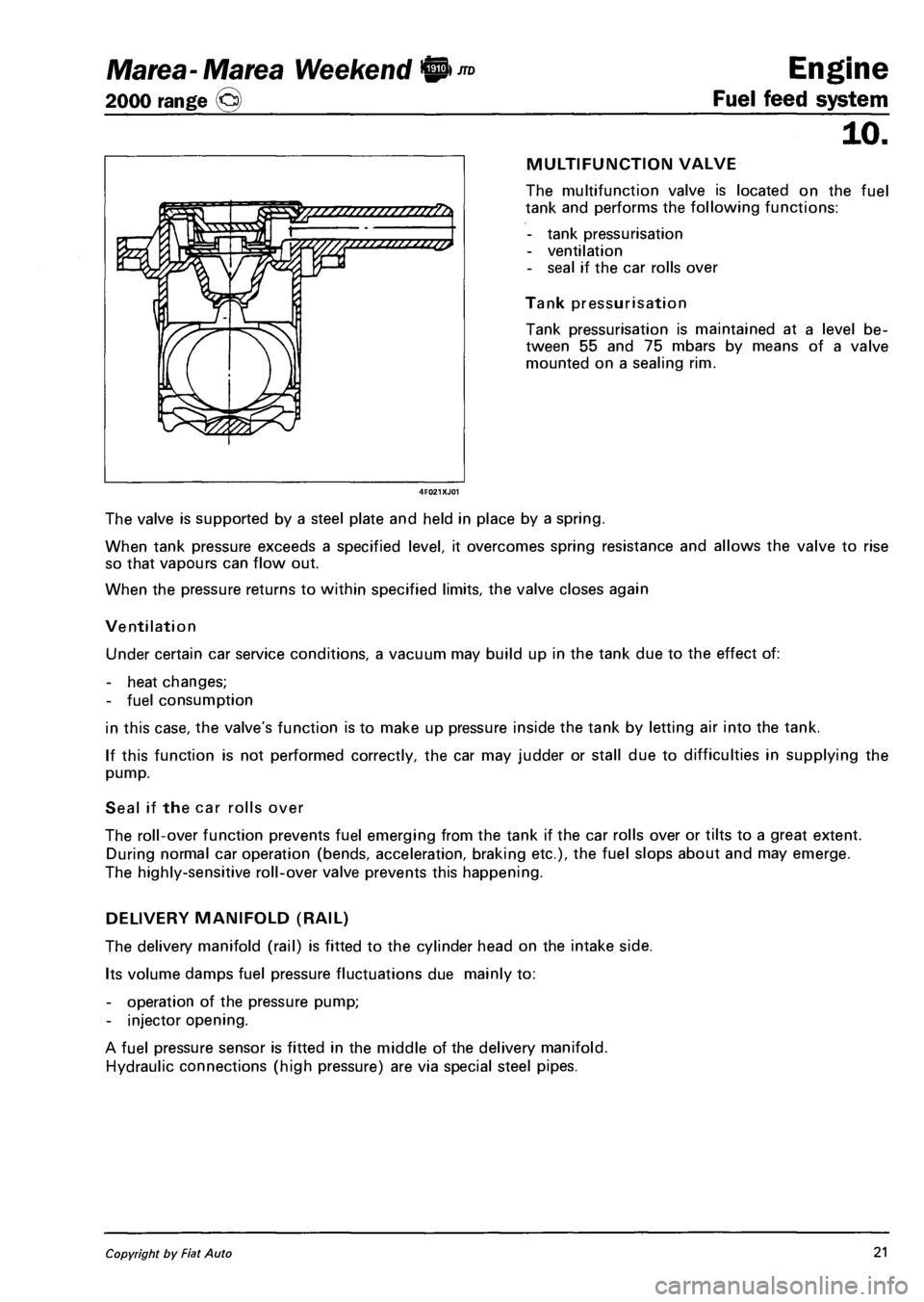
Marea- Marea Weekend <§l ™
2000 range ©
Engine
Fuel feed system
TZZZZZZZZZZZZZZZZZZb
TZZZZZZZZZZZZZZ*
10.
MULTIFUNCTION VALVE
The multifunction valve is located on the fuel
tank and performs the following functions:
- tank pressurisation
- ventilation
- seal if the car rolls over
Tank pressurisation
Tank pressurisation is maintained at a level be
tween 55 and 75 mbars by means of a valve
mounted on a sealing rim.
The valve is supported by a steel plate and held in place by a spring.
When tank pressure exceeds a specified level, it overcomes spring resistance and allows the valve to rise
so that vapours can flow out.
When the pressure returns to within specified limits, the valve closes again
Ventilation
Under certain car service conditions, a vacuum may build up in the tank due to the effect of:
- heat changes;
- fuel consumption
in this case, the valve's function is to make up pressure inside the tank by letting air into the tank.
If this function is not performed correctly, the car may judder or stall due to difficulties in supplying the
pump.
Seal if the car rolls over
The roll-over function prevents fuel emerging from the tank if the car rolls over or tilts to a great extent.
During normal car operation (bends, acceleration, braking etc.), the fuel slops about and may emerge.
The highly-sensitive roll-over valve prevents this happening.
DELIVERY MANIFOLD (RAIL)
The delivery manifold (rail) is fitted to the cylinder head on the intake side.
Its volume damps fuel pressure fluctuations due mainly to:
- operation of the pressure pump;
- injector opening.
A fuel pressure sensor is fitted in the middle of the delivery manifold.
Hydraulic connections (high pressure) are via special steel pipes.
Copyright by Fiat Auto 21